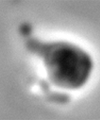February
How did early primordial cells evolve?

Research into bacteria without a cell wall is helping us understand how the earliest forms of life may have replicated nearly four billion years ago.
Four billion years ago, soon after the planet cooled enough for life to begin, primordial cells may have replicated and divided without protein machinery or cell walls, relying instead on just a flimsy lipid membrane. New research on bacteria examines exactly how these primitive cells could have evolved without such crucial structures. While the vast majority of bacteria have cell walls, many bacteria can switch to a wall-free existence called the L-form state, which could mirror the structure of primordial cells.
A study published by Cell Press in the journal Cell reveals how bacteria in this L-form state divide and proliferate, shedding light on how the earliest forms of cellular life may have replicated.
"The main surprise for me was how simple the mechanism was. It doesn’t require any sophisticated protein-based machinery," says senior study author Professor Jeff Errington of Newcastle University. "This makes it plausible as an explanation for how very primitive cells could have proliferated in the very early days of evolution."
His explanation of his work can be seen in this video.
The cell wall is a layered structure surrounding cells that protects them and maintains their shape. It is present in all known major bacterial lineages, and it was also probably present in the last common ancestor of bacteria. This structure is so important that it is targeted by antibiotics, and many bacteria responsible for infectious diseases can switch to the L-form state to resist antibiotics.
Perhaps the most striking change associated with the L-form state is the way that the bacteria replicate. Instead of relying on precise, complicated cell division machinery, L-form bacteria become irregularly shaped and form cell surface bulges that pinch off to become daughter cells. Although genetic mutations associated with the L-form state have been identified, little is known about the molecular mechanisms underlying L-form replication.
Addressing this question in the new study, Professor Errington and his team identified two genetic changes required for L-form growth in bacteria. One of these mutations was necessary for the increased production of fatty acids in the cell membrane, which would be expected to increase the cell's surface area relative to its volume. Indeed, the researchers found that by artificially increasing cell surface area, they could induce L-form-like shape changes and cell division. The findings suggest that a simple biophysical change—an imbalance between surface area and volume—underlies L-form cell division.
"Our study paves the way for understanding how L-form bacteria cause disease and resist antibiotics," Professor Errington says. "It also offers a model system for future experiments aimed at exploring the possible replication mechanisms of primitive cells that could have existed before the explosion of bacterial life on the planet nearly four billion years ago."
Watch Professor Errington explaining his work in a video to accompany the paper and find out more about the team and their work in their blog.
Press release courtesy of Cell.
published on: 28 February 2013
